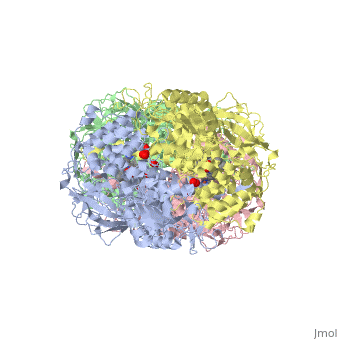1ggf
From Proteopedia
CRYSTAL STRUCTURE OF CATALASE HPII FROM ESCHERICHIA COLI, VARIANT HIS128ASN, COMPLEX WITH HYDROGEN PEROXIDE.
Structural highlights
FunctionCATE_ECOLI Decomposes hydrogen peroxide into water and oxygen; serves to protect cells from the toxic effects of hydrogen peroxide. Evolutionary ConservationCheck, as determined by ConSurfDB. You may read the explanation of the method and the full data available from ConSurf. Publication Abstract from PubMedThe active site of heme catalases is buried deep inside a structurally highly conserved homotetramer. Channels leading to the active site have been identified as potential routes for substrate flow and product release, although evidence in support of this model is limited. To investigate further the role of protein structure and molecular channels in catalysis, the crystal structures of four active site variants of catalase HPII from Escherichia coli (His128Ala, His128Asn, Asn201Ala, and Asn201His) have been determined at approximately 2.0-A resolution. The solvent organization shows major rearrangements with respect to native HPII, not only in the vicinity of the replaced residues but also in the main molecular channel leading to the heme distal pocket. In the two inactive His128 variants, continuous chains of hydrogen bonded water molecules extend from the molecular surface to the heme distal pocket filling the main channel. The differences in continuity of solvent molecules between the native and variant structures illustrate how sensitive the solvent matrix is to subtle changes in structure. It is hypothesized that the slightly larger H(2)O(2) passing through the channel of the native enzyme will promote the formation of a continuous chain of solvent and peroxide. The structure of the His128Asn variant complexed with hydrogen peroxide has also been determined at 2.3-A resolution, revealing the existence of hydrogen peroxide binding sites both in the heme distal pocket and in the main channel. Unexpectedly, the largest changes in protein structure resulting from peroxide binding are clustered on the heme proximal side and mainly involve residues in only two subunits, leading to a departure from the 222-point group symmetry of the native enzyme. An active role for channels in the selective flow of substrates through the catalase molecule is proposed as an integral feature of the catalytic mechanism. The Asn201His variant of HPII was found to contain unoxidized heme b in combination with the proximal side His-Tyr bond suggesting that the mechanistic pathways of the two reactions can be uncoupled. Substrate flow in catalases deduced from the crystal structures of active site variants of HPII from Escherichia coli.,Melik-Adamyan W, Bravo J, Carpena X, Switala J, Mate MJ, Fita I, Loewen PC Proteins. 2001 Aug 15;44(3):270-81. PMID:11455600[1] From MEDLINE®/PubMed®, a database of the U.S. National Library of Medicine. See AlsoReferences
| ||||||||||||||||||||


